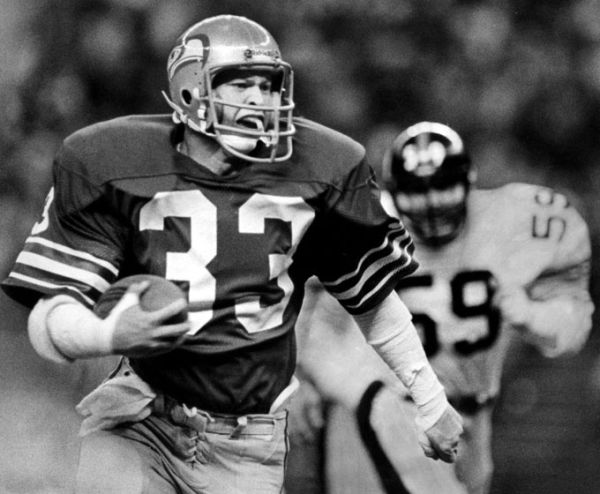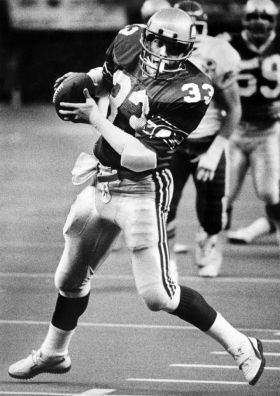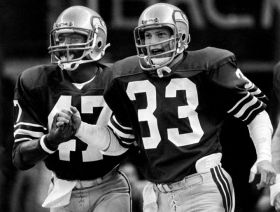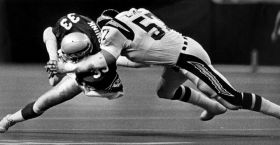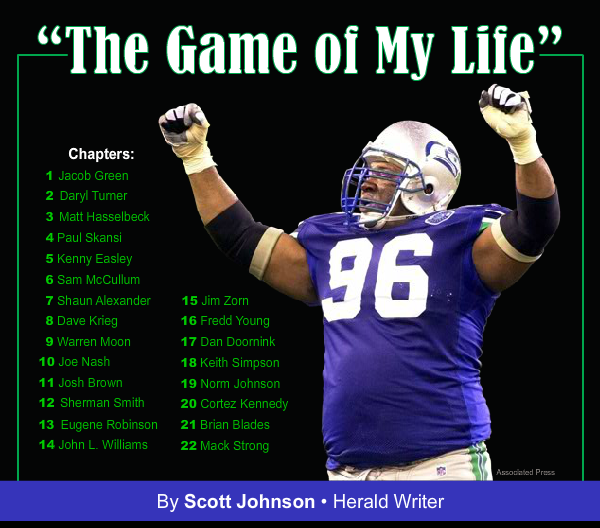During an eight-year NFL career that included seven with the Seattle Seahawks, Dan Doornink was asked to do a lot of things. He came into the league as a fullback, saw plenty of action on special teams, and started splitting time at halfback before finding his niche as a third-down back who caught plenty of passes out of the backfield.
And in 1984, the Seahawks asked "Dr. Dan," as he would later be known, to give the mighty Los Angeles Raiders some anesthesia.
With only a few days remaining before the Seahawks' playoff game against the rival Raiders, Doornink was given the surprising news that he was going to make a rare start at halfback. He was told that he had fresh legs, and that the team needed some extra juice at the position after using a rotation of starters there to replace injured star Curt Warner during the regular season.
And then the coaches told Doornink one last thing: that they were going to run the ball on almost every play.
A product of tiny Wapato, Wash., outside of Yakima, Dan Doornink will be remembered for many things during his days as a Seahawk. The one thing that will never be forgotten was the December afternoon when he put the Seahawks on his shoulders and – for a few hours, anyway – nearly made the Seattle fans forget Curt Warner's name.
Uunlike most professional football players, Dan Doornink never dreamed of playing in the NFL. Many of his Friday and Saturday nights at Wapato High School included a jam-packed gym filled with basketball fans, and he was just fine with hitting game-winning jump shots and taking back-to-back trips to the state basketball tournament and allowing those to be the highlights of his athletic career. But Doornink played a little quarterback too, and when he got an unexpected letter from the Washington State University football program, he hung up his hi-tops and decided to play for the Cougars – no matter how short-lived his football career might be.
As it turned out, the only part of Doornink's football career that got cut short earlier than expected was his tenure at quarterback. As would be the pattern of his football life, he was asked to change positions early in his freshman season because the injury-plagued Cougars were short on runners.
"There weren't enough running backs to even run the (practice) drill," Doornink recalled of his first position switch. "There were a few guys standing around, including myself and (future NFL quarterback) Jack Thompson. Jack had tree-trunk legs and wasn't the fastest guy, so the coach looked over at me and said: 'Dan, why don't you step in there?'
"Within two weeks, I was starting as a freshman."
That was in 1974, the first year the NCAA allowed freshmen to play in varsity games. Doornink became the starting tailback and never played quarterback again (though he continued to wear the No. 11 jersey he'd taken as a quarterback). The converted tailback started every game of his freshman season before being moved to fullback as a sophomore. Starting at his new position, Doornink set a WSU sophomore record with 607 rushing yards – despite missing three games with broken ribs.
The change in positions would open the door to a possible NFL career, although Doornink had no way of knowing that at the time. The converted fullback turned out to be a pretty good blocker, and Doornink proved to be quite a receiver out of the backfield as well, catching a team-high 53 passes as a junior. He continued to have success his senior season with the Cougars, eventually getting named to the Pac-8 roster at the Challenge Bowl. Playing in a game that featured his conference's best players matching up against the best from the Big 8, Doornink rushed for 142 yards in that game on the way to Most Valuable Player honors. After that, Doornink became an immediate NFL prospect.
The next spring, the New York Giants selected him in the seventh round of the 1978 NFL draft. With an aging fullback in future Hall of Famer Larry Csonka, the Giants were looking for someone to learn on the job and eventually take over as starter.
Doornink saw a lot of playing time as a rookie, and not just on special teams. He scored a touchdown on his first professional carry and started two games that year. One of those starts was a legendary game between the Giants and Philadelphia Eagles that would continue to get replayed over the years because of its improbable finish. Doornink was the fullback for most of that Nov. 17, 1978, game, but the Giants decided to put Csonka on the field for their final drive because they were leading by four points and needed a sure-handed veteran who could carry the ball and run out the clock. With Doornink watching from the sidelines, Csonka and Giants quarterback Joe Pisarcik botched the final handoff and sent the football falling to the turf. Eagles defensive back Herman Edwards scooped it up in stride and ran 26 yards for the game-winning touchdown as time expired. The play is known as the Miracle at the Meadowlands, and it remains an NFL blueprint for why quarterbacks should kneel down instead of attempting to hand the ball off when burning time off the clock.
But that would be one of the few memories from Doornink's career in New York, as the Giants decided to trade him on the eve of the 1979 season. The move came as a shock to the second-year fullback, not only because he was getting meaningful playing time but also because he and his new wife, high school sweetheart Sharon, were starting to fall in love with the Big Apple.
"It's fun for newlyweds in New York," recalled Doornink, who got married in that city during his rookie year. "We got to do something fun every Tuesday, whether it was seeing Yul Brenner in 'The King and I,' or going to the Museum of Natural History. It was a fun time for newlyweds.
"And I went from being the starter in New York to who-knows-what in Seattle. They already had seven running backs, and one had to go, so I didn't know what was going to happen."
The Seahawks, who had given up a seventh-round pick to acquire Doornink, kept him around. Despite the presence of starting fullback Dave Sims, Seattle was looking for help on special teams. And Doornink certainly fit the bill. But when Sims suffered a career-ending neck injury in the first month of the regular season, Doornink suddenly became the Seahawks' starting fullback. In his fifth start as a Seahawk, Doornink rushed for 122 yards and two touchdowns in a 31-28 win over Atlanta. He ended up starting 12 games that year, rushing for 500 yards and eight touchdowns.
But Doornink didn't get many opportunities to carry the ball in the following years. He had 100 attempts while starting 14 games in 1980, then split time with other fullbacks like Jim Jodat in 1981 and David Hughes in 1982 and '83. He continued to shine as a receiver out of the backfield, so Doornink's role on the team soon consisted of blocking and catching third-down passes out of the backfield.
He continued in the role of third-down back in 1984, but a Week 1 injury to star Curt Warner forced him to see some time at halfback. Doornink, Eric Lane and Zach Dixon all filled in for Warner at the position, but come playoff time there was no clear-cut starter. That's the week when Doornink got the most surprising news of his young career. In the days leading up to a postseason game against the Los Angeles Raiders, Doornink was told that he would start the game. He had started only three times during the entire 1983 and '84 seasons combined, so coach Chuck Knox's decision was met with surprise from some and disinterest by others. With a high-powered passing game that featured quarterback Dave Krieg and receiver Steve Largent, the Seahawks were the kind of team that could throw the ball no matter who was in the backfield. So the news of a new starting running back didn't raise too many eyebrows.
"I took that as sort of a personal challenge," Doornink recalled.
Knox, whose previously conservative nature and passion for calling run plays had earned him the nickname Ground Chuck, had a little trick up his sleeve for the hated Raiders. Not only would he go back to his old style of offense, but Knox was going to do it while using a converted fullback who'd had just 57 carries all season. Recalling the memory in 2007, Knox said he had to run the ball because the Seahawks were missing their starting left tackle, Ron Essink, due to injury.
"I had to go with a (left tackle) who hadn't played, so I said: I'm going to run the football," Knox recalled. "I didn't want to get the quarterback killed."
The stage had been set for the greatest game of Dan Doornink's life.
Los Angeles Raiders vs. SeahawksDecember 22, 1984
as told by Dan DoorninkThere was quite a bit of hype. It's holiday time, and the Seattle metro area is going wacko over the game. When we get to the ballpark, you usually go out to warm up while everyone's still walking in, but we went out and everyone was already there. It was a wild deal, enough to get your adrenaline going. I'm not an adrenaline guy; I usually didn't get that keyed up for games. But that game, it was just electric. There were all the 'Raider Buster' shirts or whatever was the deal in those days.
You could be two feet away from a guy on the field, and he could be yelling at you, and you couldn't hear what he was saying. So when the Raiders were trying to call their plays and call audibles, there was no way you could hear anything.
Because of Curt Warner's injury, we had to limp through the season with a running back-by-proxy operation. We didn't have any outstanding running backs, but we had an outstanding defense; our defense was awesome. So if we could not turn the ball over and score a few points, we would win a few games. That was the philosophy going into the playoffs that year.
We're playing a Raider team that has an excellent defense too. But they have an offense where we think we can stone them. And we're playing in the Kingdome, which cuts down on the abilities of an opposing offense just because it's so loud in there. As it was in those days, the Seahawks generally had a simple offensive plan. While we did have some sneaky things on third downs and stuff, we didn't have a big package on offense. We had Dan and David Hughes, and that's what we were going to do.
The Raiders got the ball first, and my recollection is that we had a couple big defensive plays and a big hit on special teams. And when we get the ball, we run a play called the 34 Dive. It's a dive play, where I line up in the 'I' position, they hand it to me, and I go over the tackle. It was to the side where Howie Long was playing defensive end for the Raiders. If Howie goes inside, I go outside. If he goes to the outside, I turn it up inside. It's a pretty simple play.
So we run that play. Then we run the same play, with me as the blocker and David Hughes as the ball carrier. Then we ran the 34 again. And again. Same play and same play. Same play, same play, same play. Some of the time I'd move over and block, but most of the time I'd be carrying the ball.
It was a defensive struggle because our goal was to occupy the ball and not turn it over. We ran 18 times in the first half and threw just four passes. One of them went for a touchdown, from Dave Krieg to Daryl Turner, to give us a 7-0 halftime lead.
Then we went back to the run. Again and again. Same play. We just kept going like that. We threw only 10 passes in the game, and a couple of them were play-action passes. We basically ran the same play every single time. We had them back on their heels. It was an unexpected move by Chuck Knox. I'm sure they were expecting us to have to pass or do shenanigans to win the game, but we just wanted to grind it out, five yards or six yards or eight yards at a time. It was usually third-and-2, and we'd run it again. We just didn't have to pass that much in the game.
I recall a time in the middle of the third quarter, and I'm sitting in my stance at tailback. Sometimes you can see right into an opponent's eyes. I could see right into Howie's eyes. Back in those days, he was such a powerful guy. That's why you ran plays right at him. He'd dominate his offensive lineman so much, that you'd go at him, see what direction he went, then run away.
Anyway, I looked him in the eyes, and nodded my head like: 'Yup, it's the same play again.' And it went for 15 yards.
So they took out one of their safeties and put in a fourth linebacker. They had a four-man line, four linebackers, only three defensive backs. And they still couldn't stop us. We kept running it at them.
It was a dominating game all around. Those were the days when the Seahawk-Raider rivalry was a great thing. Out on the field, if there was a fight or guys pushing, I'd go over to Matt Millen and push him and say, 'How about you?' But it was all in fun. They were good guys. We had respect for them, and they had respect for us.
It's not like we had this overpowering offensive line. We didn't have the most gifted line, we just had a bunch of guys that had the will to win. In fact, our left tackle, Ron Essink, was hurt and we had to bring in a sub. That was the only game Sid Abramowitz ever started for us at tackle. It was a superb game plan; but you need a game plan, and then you need guys who can execute it. We had not-flashy guys, but guys who could execute; guys with a lot of will. David Hughes was my blocker, and I was his blocker. Steve Largent was out there blocking the defensive backs.
As it turned out, we had a few good plays and dominated the game. We didn't have any turnovers, the defense did a good job, and we won 13-7. We ran the ball 51 times and threw just 10 passes, only four of which were complete. I had 126 yards, the highest total of my career, on 29 carries. David Hughes carried the ball 14 times for 54 yards.
The odd thing after that game is the Raiders had lots of good things to say about us afterward. Howie Long said something like, 'Dan Doornink had a heart as big as the Kingdome,' or something like that. The amazing thing was that both Matt Millen and Howie Long gave me a call at my home the next day. I didn't even have a listed number. No idea how they got my number, but they called me to congratulate me.
That game put us in the national spotlight. I can still picture Kenny Easley running back a punt and making an interception and making some amazing hits. There was that magic in the dome, and there was that magic in the city too.
The magic did not last – for Doornink or the Seahawks. The year after his breakout game against the Raiders, Doornink suffered a broken fibula that ended his season prematurely. While he came back from the injury for the following training camp, in 1986, the time away had put his mind on life after football. He was ready to move on with his life.
During the 1980 season, Doornink's third in the NFL, he had quietly started taking classes at the University of Washington medical school in preparation for his post-football career. It would prove to be a pivotal decision in his future, especially when football was taken out of his life earlier than he had hoped.
So when the struggling Seahawks cut Doornink after the 1986 training camp, there was a part of him that felt relieved. His football career was over, and it was time for the medical career to begin. He went back to medical school the following day, and got his Ph.D. less than a year later.
"There's always this saying during cut time, and the saying was: 'It may be time for you to get on with you life's work.' And that held true for me," said Doornink, who went on to have a successful medical career as an internist on the eastern side of Washington state. "I played longer than I ever would've guessed. Even though I wanted to play one more year, it turned out that it worked out perfectly."
The man who now answers to "Dr. Dan" has moved on to much more important work than playing football. While he spends his time saving lives now, he'll never forget the time he saved an injury-depleted football team from playoff extinction.
And neither will the Seahawks fans.

